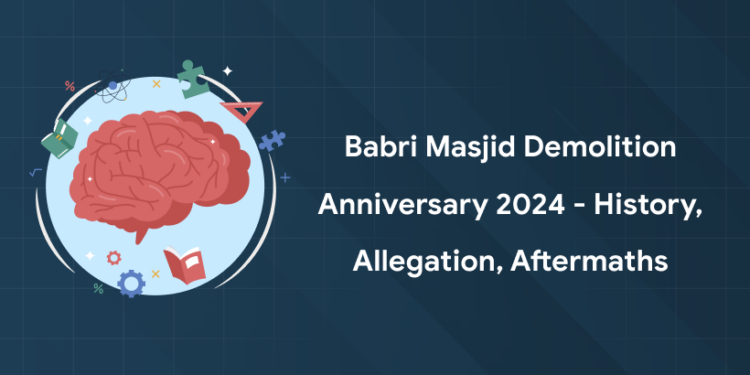Table of Contents
December 6, 1992, marks a pivotal day in India’s history—the demolition of the Babri Masjid in Ayodhya. This event reshaped the nation’s socio-political landscape, fueling debates on religion, politics, and communal harmony. As we observe its 32th anniversary in 2024, it’s essential to revisit the historical context, the events that unfolded, and the enduring impact on India’s collective conscience.
When Was the Babri Masjid Built?
The Babri Masjid was constructed between 1528 and 1529 in Ayodhya, Uttar Pradesh, under the leadership of Mīr Bāqī, a commander in the army of Mughal Emperor Babur. As one of the three mosques built by Babur’s reign, the mosque featured distinctive seven arches, a central arch, domes, and a water tank. The mosque later became a center of controversy, with disputes over its location, which some believed was the site of a pre-existing Hindu temple.
Babri Masjid Demolition Anniversary 2024 Date
1: Who was the first woman President of India?
On December 6, 1992, the Babri Masjid in Ayodhya, Uttar Pradesh, was demolished by a mob of kar sevaks during a rally organized by the RSS, VHP, and BJP. The incident sparked widespread communal riots and marked a turning point in India’s political and religious history, leaving lasting social impacts.
Free UPSKILLING Courses!
Take your first step toward mastering in-demand skills, acing interviews, and securing top-tier jobs with Entri's free upskilling courses.
Start Learning!Why was Babri Masjid Demolished?
The Babri Masjid was demolished on December 6, 1992, by Hindu activists during a rally organized by the RSS, VHP, and BJP, claiming the site as Ram Janmabhoomi, Lord Ram’s birthplace. They alleged the mosque was built by demolishing a temple in 1528. The act, seen as politically and religiously motivated, led to communal riots and deepened Hindu-Muslim tensions.
Babri Masjid Demolition History 2024
The history of the Babri Masjid and its eventual demolition is a deeply complex and contentious chapter in India’s socio-political landscape. The Babri Masjid, constructed in 1528 by Mughal commander Mir Baqi, is believed to have been named after Emperor Babur. According to popular belief, the mosque was built after demolishing a Hindu temple marking the birthplace of Lord Rama, though historical evidence for this claim remains debated.
The site in Ayodhya became a focal point for both Hindus and Muslims, with records indicating shared religious usage for over four centuries. The dispute over its ownership first emerged in 1822 and intensified during British colonial rule, leading to the erection of barriers to separate worshippers of both faiths. In 1949, idols of Lord Rama were placed inside the mosque, sparking further tensions. The site was declared disputed, and legal battles ensued.
The conflict gained political momentum in the 1980s, with the Vishva Hindu Parishad (VHP) advocating for the construction of a Ram temple and the Bharatiya Janata Party (BJP) lending political support. A court ruling in 1986 allowed Hindus to worship at the site, reigniting the controversy. The BJP’s Rath Yatra in 1990, led by L.K. Advani, further polarized communities and paved the way for the party’s political ascendancy.
On December 6, 1992, a rally by the RSS, VHP, and BJP attracted over 150,000 supporters to Ayodhya. Despite assurances from Uttar Pradesh Chief Minister Kalyan Singh to protect the mosque, it was stormed by a mob and demolished within hours. This event triggered nationwide riots, claiming thousands of lives and reshaping India’s political and communal landscape.
The Liberhan Commission, established to investigate the demolition, held 68 individuals, including prominent BJP leaders, responsible. The 2019 Supreme Court verdict eventually awarded the disputed land for temple construction, bringing a legal resolution but leaving the social scars intact. The Babri Masjid dispute remains a symbol of the complex interplay between faith, politics, and history in India.
Babri Masjid Demolition First Man
On December 6, 1992, journalist Sajeda Momin witnessed the demolition of the Babri Masjid by a crowd of Hindu nationalists in Ayodhya. The mosque’s domes collapsed within hours, following earlier riots in 1990 over the site’s religious significance. The demolition triggered widespread violence, causing over 2,000 deaths.
Free UPSKILLING Courses!
Take your first step toward mastering in-demand skills, acing interviews, and securing top-tier jobs with Entri's free upskilling courses.
Start Learning!Demolition of Babri Masjid Allegations
The Babri Masjid demolition faced serious allegations of being premeditated. Former Intelligence Bureau chief Maloy Krishna Dhar alleged in his 2005 book that the event was orchestrated 10 months in advance by leaders of the RSS, BJP, and VHP, with strategic planning and intent to further the Hindutva agenda. Dhar claimed evidence, including tapes of key meetings, was shared with top government officials, including Prime Minister P.V. Narasimha Rao, who allegedly failed to act decisively.
A 2014 Cobrapost sting operation reinforced these allegations, claiming the demolition was a well-coordinated sabotage rather than a spontaneous mob action. It revealed that organizations like the VHP and Shiv Sena had meticulously planned the event months ahead, although separately. These claims highlight the deliberate and politically motivated nature of the incident, sparking debates over the accountability of involved organizations and individuals.
Babri Masjid After Demolition – Aftermath
The aftermath of the Babri Masjid demolition on December 6, 1992, was marked by widespread communal violence, international reactions, and significant socio-political repercussions:
Communal Violence
The demolition triggered massive communal riots across India, with cities like Mumbai, Delhi, and Ahmedabad witnessing severe clashes. Over 2,000 lives, primarily of Muslims, were lost, and property worth billions was destroyed. The violence culminated in the 1993 Mumbai bombings, believed to be retaliation for the riots. The incident also became a rallying point for extremist groups like the Indian Mujahideen.
Investigation and Legal Proceedings
The Liberhan Commission, established shortly after the demolition, concluded the event was pre-planned and implicated senior BJP and Sangh Parivar leaders. However, in 2020, all 32 accused were acquitted by a special court due to a lack of conclusive evidence. The judiciary’s handling of the case remains a subject of debate.
International Reactions
The demolition elicited strong reactions globally:
- Pakistan: Violent protests led to attacks on Hindu temples and Indian institutions. Many Pakistani Hindus faced discrimination and sought refuge in India.
- Bangladesh: Temples and Hindu properties were targeted in riots, disrupting communal harmony and festivals.
- Middle East: Countries like Saudi Arabia and Iran condemned the act, while the UAE experienced violent protests. Some participants were arrested and deported.
- United Kingdom: Hindu temples and community centers faced arson and vandalism in retaliation.
Cultural Impact
The demolition and its aftermath inspired several works in literature, cinema, and documentaries:
- Films like Bombay and Black Friday depicted the riots and subsequent bombings.
- Books like Taslima Nasrin’s Lajja explored the persecution of Hindus in Bangladesh following the incident.
- Documentaries like Ram ke Naam critically examined the socio-political dimensions of the dispute.
The Babri Masjid demolition remains a pivotal moment in India’s modern history, symbolizing deep religious and political divides while shaping discourse on secularism and communal harmony.
Supreme Court Verdict on Babri Masjid
The Supreme Court of India delivered its landmark judgment on the Ayodhya dispute on November 9, 2019, unanimously resolving the decades-long conflict. The five-judge bench, comprising Ranjan Gogoi (former Chief Justice), S.A. Bobde (former Chief Justice), D.Y. Chandrachud (former Chief Justice), Ashok Bhushan, and S. Abdul Nazeer (both retired judges), ruled in favor of constructing the Ram Janmabhoomi temple on the disputed 2.77-acre site, revered by Hindus as Lord Ram’s birthplace. The land was awarded to a trust to be formed by the government for temple construction.
In a gesture to balance interests, the Court directed the government to allocate 5 acres of land in Ayodhya to the Uttar Pradesh Sunni Central Waqf Board to build a mosque as compensation for the demolished Babri Masjid.
The judgment also acknowledged that the demolition of the Babri Masjid in 1992 and its desecration in 1949 were unlawful acts. Archaeological evidence presented by the Archaeological Survey of India indicated the mosque was built over a non-Islamic structure.
The verdict overruled the 2010 Allahabad High Court decision to divide the disputed land into three parts, instead granting sole ownership of the site to the Ram Temple Trust. The Court emphasized the need for peace and unity in the aftermath of its decision.
This historic judgment, delivered by a distinguished bench, marked a significant moment in India’s socio-political history, bringing closure to one of the country’s most sensitive disputes.
Babri Masjid Demolition Timeline
- 1528-1529: Babri Masjid built by Mir Baqi under Emperor Babur.
- 1853: First religious clashes at the site.
- 1949: Idols placed inside; site declared disputed.
- 1986: Gates reopened for Hindu worship.
- 1992: Mosque demolished on December 6.
- 1992-1993: Nationwide riots follow.
- 2009: Liberhan Commission blames leaders for planned demolition.
- 2019: Supreme Court awards land for Ram Temple.
- 2020: Ram Temple foundation laid.
Babri Masjid Demolition Quiz 2024
- When was the Babri Masjid demolished?
- A) December 6, 1990
- B) December 6, 1992
- C) November 9, 2019
- D) December 6, 2000
- Answer: B
- Who was the Mughal emperor when Babri Masjid was constructed?
- A) Akbar
- B) Babur
- C) Aurangzeb
- D) Humayun
- Answer: B
- In which state is Ayodhya located?
- A) Uttar Pradesh
- B) Madhya Pradesh
- C) Rajasthan
- D) Bihar
- Answer: A
- What was the size of the disputed land in the Ayodhya verdict?
- A) 3.5 acres
- B) 2.77 acres
- C) 5 acres
- D) 10 acres
- Answer: B
- Which political party was in power at the center during the demolition in 1992?
- A) BJP
- B) Congress
- C) Janata Dal
- D) Samajwadi Party
- Answer: B
- Who formed the Liberhan Commission?
- A) Atal Bihari Vajpayee
- B) P. V. Narasimha Rao
- C) Rajiv Gandhi
- D) V. P. Singh
- Answer: B
- Which religious structure was claimed to have existed under Babri Masjid?
- A) Buddhist Stupa
- B) Hindu Temple
- C) Jain Temple
- D) None of the above
- Answer: B
- Which organization spearheaded the Ram Janmabhoomi movement?
- A) Rashtriya Swayamsevak Sangh (RSS)
- B) Hindu Mahasabha
- C) Vishva Hindu Parishad (VHP)
- D) Bharatiya Janata Party (BJP)
- Answer: C
- When was the Allahabad High Court verdict delivered in the Ayodhya dispute?
- A) 2002
- B) 2005
- C) 2010
- D) 2019
- Answer: C
- What alternative land area was allotted to the Sunni Waqf Board in the 2019 verdict?
- A) 5 acres
- B) 2.5 acres
- C) 10 acres
- D) 1.5 acres
- Answer: A
The Babri Masjid demolition marks a significant chapter in India’s history, symbolizing religious tensions, legal battles, and societal impacts. The Supreme Court’s verdict sought resolution, promoting unity through temple construction and mosque allocation. This anniversary urges reflection on peace, justice, and coexistence to strengthen communal harmony.













